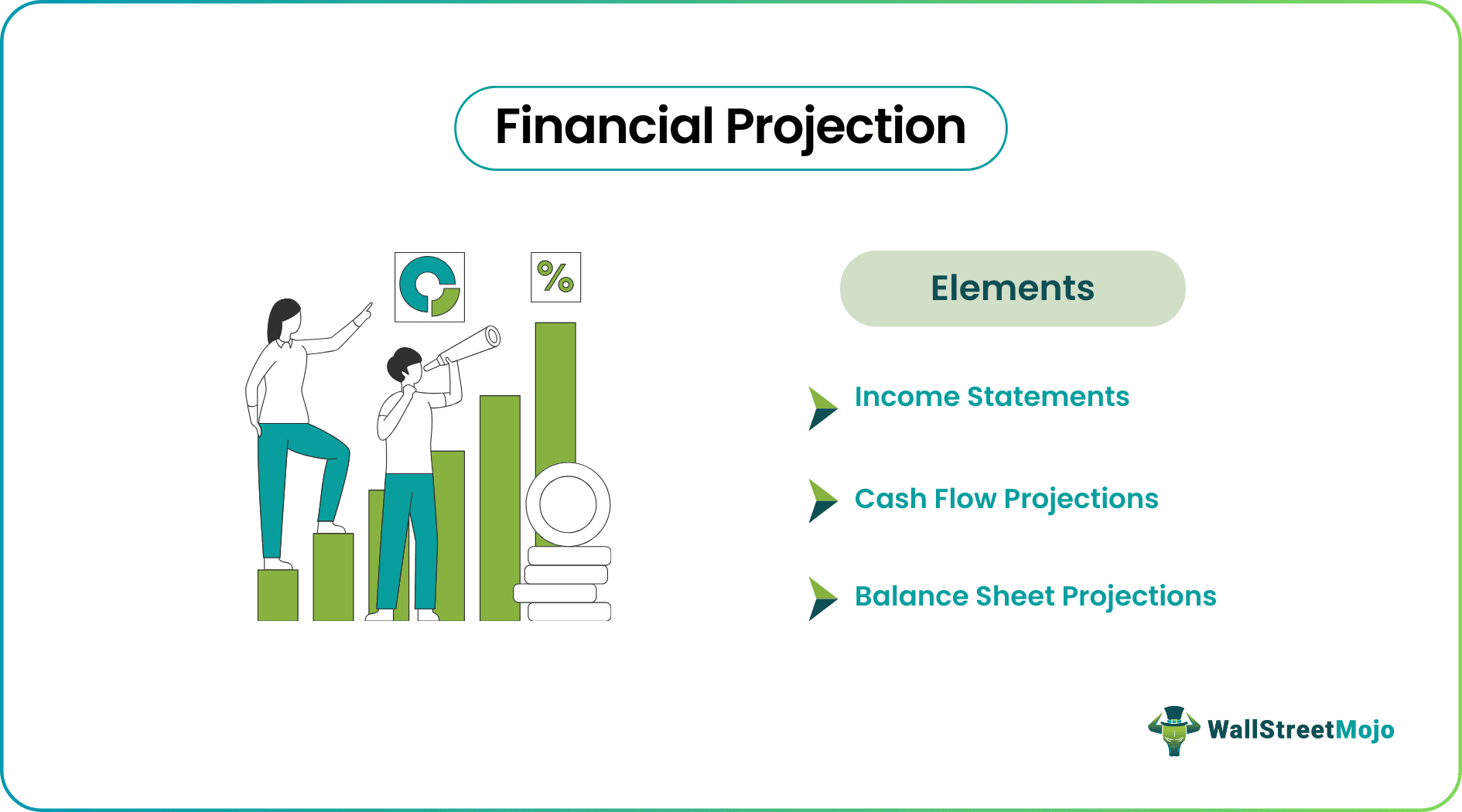Table Of Contents
What Is Financial Projection?
The financial projection shows forecasts and predictions on the financial estimates and numbers that range from revenues and expenses pertaining to financial statements and takes external market factors and internal data into account.

The financial projections are a decision-making tool for the management and creditors. It is a concise financial model that shows forecasts basis the estimates as determined by the administration itself. It may be used by lenders and creditors to base their investment decisions.
Key Takeaways
- Financial projection meaning refers to estimates related to the financial performance and condition of an organization during a specific timeframe.
- Such estimates provide investors and analysts with an idea regarding the company’s expected income and expenses.
- There are different kinds of projections. A few examples are cash flow, capital budgeting, and operating budget projections.
- A noteworthy benefit of such projections is that they help the management team establish targets and spot warning signs concerning business performance.
- Typically, businesses create financial projections with a long-term approach. On the other hand, they carry out financial forecasting for short-term predictions.
Financial Projection Explained
The process of financial projection in business plan explains the estimates and the future forecasts made regarding the business’s financial condition and performance during a particular period. It may be for the coming year or the next few financial years. These estimates and projections are calculated based on some factors like past performance of the business, the current economic conditions, the market volatility, the demand, and supply of the products and services.
These financial projection statement give the analysts and investors an idea about the anticipated revenue and expenditure of the company, the cash flows, the estimated profits and future potential regarding growth opportunity and expansion. This helps them in making informed financial decisions about whether to invest in this company or not.
Even the lenders can assess the financial condition and growth opportunity of the entity and them decide whether it is worthwhile to lend money to this venture and the level of risk involved in the process. The data regarding financial projection helps in assessing the credit worthiness of the company.
How To Make A Financial Projection?
The process should be based on well supported and realistic facts and figures after accounting for the condition of the market, the current trends of the particular sector or industry, the past data and the requirements and condition of the business.
The determination of the right financial projection in business plan depends on external factors, namely economic conditions and market sentiments.
The internal factors that are inculcated into the projection are the current business position and available historical data that is utilized to derive consistency. It helps the stakeholders provide comprehensive estimates of chosen line items. Generally, they are formed as part of the executive summary. These statements can be described as forward-looking statements.
Financial projection statement gives management a concise idea and image of how the company would perform. However, merely preparing the projection is not enough for the entire process. It is equally important to regularly review and update the projections as per the changes in the factors on which it depends, so that the entire financial system of the business is accurate and relevant.
Example
Let us take the example of the Income Statement of ABC Company. It is anticipated that the revenues are going to increase by 25 percent from the base year revenues. The cost of sales for the projected income statement would be 65 percent of projected sales.
The operating expense amounted to 15 percent of the sales generated by the business, and the interest expense amounted to be the same as compared to the base year income statement. The interest expense for the base year was reported at $2,000. The business is taxed at a rate of 25 percent. Help the management prepare a projection on the income statement. The base year income statement is as follows: -

Prepare the Projected Income statement as displayed below: -
Step #1 - Initialize the revenue estimates, asset position, liabilities position, and base it on the revenues or the current asset size of the business. In the above example, revenue estimates increase by 25 percent for the base year.
Step #2 - Baseline the cost of sales, basis the revenue estimates determined above, and as shown in the example below.
Step #3 - Calculate the gross profit as the difference in revenues and cost of sales.
Step #4 - Determine the operating expenses as 15 percent of the sales or the revenue estimates.
Step #5 - Determine earnings before interest and taxes by taking up a difference between gross profit determined in step 3 and operating expenses at step 4.
Step #6 - Deduct the base-lined interest income as assumed from the prior year from the results of step 5 to arrive at the earnings before taxes.
Step #7 - Deduct the taxes from the earnings before taxes to arrive at the profit after taxes. The tariffs are determined as the 25 percent of revenues before taxes, as defined in step 6.
The following shows the calculation on the income statement as shown below: -

The following would be the projected income statement: -

Elements
The financial projections for startups or for big companies can be termed as a summarized financial model. It could be based on assumptions and estimates, as well as growth functions. A node can comprise the income statements, cash flow projections, and balance sheet projections.
#1 - Income Statements
The income statement usually comprises estimates and projections on revenue and expenses along with net income.
#2 - Cash Flow Projections
The cash flow projection usually comprises revenues collected in cash form—the disbursements of cash display all the expenses incurred by the business on a cash basis.
#3 - Balance Sheet Projections
The balance sheet projects or describes the net worth of the business. Projections can be prepared for the assets, equity, and liabilities of the balance sheet. Assets represent items that are of economic value and importance for the business. Liabilities represent items that the company owes to the creditors.
Equity is generally determined as the difference between the assets and liabilities. The expenses present in the income statement can be based on the percentage of revenues. The taxes can be assumed as the rate prescribed by the government. The assets and liabilities of certain types can also be based on the prior year asset position or last year's sales achieved by the business.
If you wish to develop a practical understanding of making cash flow, income statement, and balance sheet projections, opting for this Financial Modeling 2-Day Bootcamp can help. The boot camp is led by an experienced instructor who uses real-world examples to explain how one can create financial statement projections easily in Excel and build a financial model step-by-step.
Types Of Financial Projections
Let us look at some types of financial projections that focus on specific areas of an organization.
- Operating Budget: These projections can help organizations determine what amount they may require to carry out future operations. Based on such projections, companies can decide whether to spend on research or marketing or whether any change is required in the pricing strategy.
- Cash: These projections give an idea of the future costs associated with investments in new technologies or processes, product development, or marketing. Such projections are crucial for figuring out what amount might be available as a surplus or for investment in the future.
- Treasury: Such projects can help a company know how much money an organization would need to fund investments and operations in the future.
- Capital Budgeting: These projections can help businesses know the possible outcome of investing in long-term projects. These projections also show what resources a company may require for a specific project.
- Sale of Company: These projections help business owners figure out what might happen if they sell the organization or discontinue operations.
Financial Projection Best Practices
Let us look at some of the practices individuals can follow to ensure more accurate projections.
- Analysts should consider adopting a bottom-up approach. It involves starting with individual performance data and building up to the total revenue estimates instead of depending on top-down projections.
- One must create different scenarios, considering both the worst and best-case scenarios. That said, it is important to create middle-ground scenarios that might materialize as well.
- Individuals should adopt a conservative approach, but they should be careful not to become too conservative. One should avoid making overly optimistic estimates.
- It is crucial to collaborate with experts from different departments, like marketing, finance, and sales, to accumulate inputs and validate assumptions.
- Individuals can make more accurate financial projections if they adopt an objective approach by factoring in some key aspects, like current performance and historical data. Also, they need to conduct thorough research to assess the possibilities of a potential shift concerning customer demand.
- Lastly, one must evaluate the accuracy of projections on a regular basis. Over time, individuals can figure out whether the financial forecasts were accurate or way off.
Importance
- The financial projections for startups or for big companies is a concise financial model. Helps in the determination and planning of the requirements of working capital for the success of the business operations.
- The projection is one of the essential inputs utilized in the preparation of Strengths, weakness, opportunities, and threat analysis. It is also a supplemental report used for industry analysis.
- In the absence of the actual financial statements, projections can be shared by the business to their stakeholders and creditors.
- Doing so ensures retention in investor confidence and helps businesses getting new investments for their latest projects. The financial targets are metrics that the company has to meet for success and survival in the competitive environment and industry.
- The financial projections allow the top management to detect early warning signs for business performance and enable a business to catch potential deviations.
- It helps prepare the budget for different departments and business units working under a more prominent organization.
- It gives a clear picture of the management of how the company is going to perform.
- Projections help in making strategic decisions on business operations and growth.
- The financial projections become reference statements along with available financial statements for the lenders and creditors.
- The lenders and creditors take the projection into account as a basis for making further investment decisions towards a basis.
- It helps the management establish targets and establish early warning signs related to business performance.
- It provides summarized information to the stakeholder in the absence of financial statements. If they wish, they can ask the business to present detailed financial projections to see whether the company intends to meet its business targets.
Financial Projection Vs Financial Forecast
The above two terms are commonly used in the financial world. Let us understand the differences between them.
- The financial projection report is a financial estimate or prediction of the performance over a period of time and the latter is just the prediction of the company’s financial performance.
- The former is more towards a longer-term approach whereas the latter is a short term approach.
- The former estimates the revenue, profits, cash flows of a few years, whereas the latter estimates the capital requirements for daily operations of the business.
- The former is used for budgeting, making future financial plans and investments, whereas the latter is used for fundraising or business expansion.
However, both terms are closely related to assessing the future financial performance, and their interpretation depends on the context and the type of organization.

